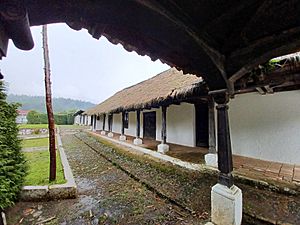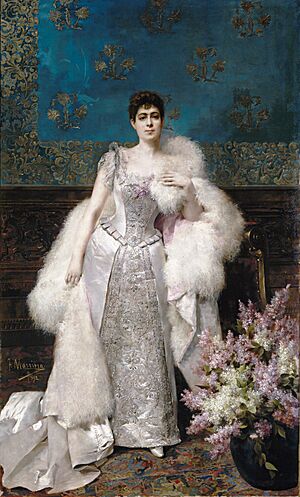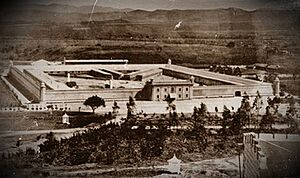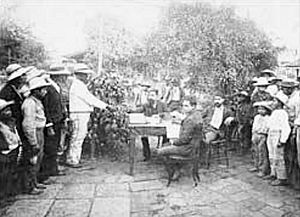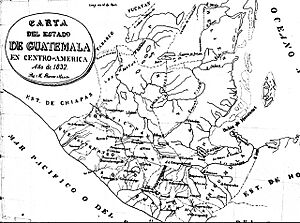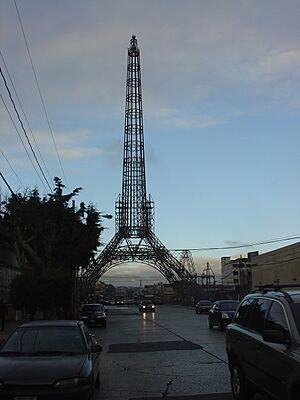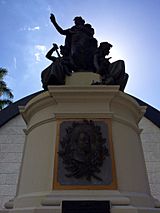Justo Rufino Barrios facts for kids
Quick facts for kids
General of Division
Justo Rufino Barrios
|
|
|---|---|
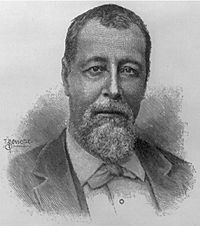
Barrios in 1884
|
|
| President of Guatemala | |
| In office 4 June 1873 – 2 April 1885 |
|
| Deputy | José María Orantes Alejandro M. Sinibaldi |
| Preceded by | Miguel García Granados |
| Succeeded by | Alejandro M. Sinibaldi |
| President of the Republic of Central America | |
|
Provisional
|
|
| In office 28 February 1885 – 2 April 1885 |
|
| Preceded by | Position established |
| Succeeded by | Position abolished |
| Provisional Head of the Government of Guatemala | |
| In office 30 June 1871 – 4 June 1873 |
|
| President | Miguel García Granados |
| Preceded by | Position established |
| Succeeded by | Position abolished Julián Salguero (as First Vice President) |
| Personal details | |
| Born |
Justo Rufino Barrios Auyón
19 July 1835 San Lorenzo, San Marcos, Federal Republic of Central America (now in Guatemala) |
| Died | 2 April 1885 (aged 49) Chalchuapa, El Salvador |
| Political party | Liberal |
| Spouse | Francisca Aparicio |
| Relatives | Celia Barrios de Reyna (sister) |
| Residence | Guatemala City |
| Profession | Army General |
Justo Rufino Barrios Auyón (born July 19, 1835 – died April 2, 1885) was a very important leader in Guatemala. He was a military general and served as the President of Guatemala from 1873 until he died in 1885. He is remembered for making many big changes, called liberal reforms. He also tried to bring the countries of Central America back together into one big union.
Contents
Early Life and Education
Justo Rufino Barrios was born in a town called San Lorenzo in Guatemala. Even when he was young, people noticed he was very smart and full of energy. He moved to Guatemala City to study law. In 1862, he became a lawyer.
How Barrios Became President
In 1867, a rebellion started in western Guatemala. Many people there wanted their region, called Los Altos, to be an independent state again. Barrios joined these rebels in Quetzaltenango. He quickly showed he was a great military leader and soon became a general in the rebel army.
By July 1871, Barrios and other leaders decided to overthrow the old Conservative government of Guatemala. They succeeded! General Miguel García Granados became president, and Barrios was put in charge of the army.
However, many people in their own party thought García Granados was not strong enough. They wanted elections, believing Barrios would be a better president. So, in 1873, Justo Rufino Barrios was elected president of Guatemala.
Barrios' Time as President
When Barrios became president, the Conservative government in Honduras supported some Guatemalan Conservatives who wanted to take back control. Because of this, Barrios declared war on Honduras. At the same time, Barrios and the President of Honduras, Luis Bogran, announced they wanted to reunite the old United Provinces of Central America.
During his time as president, Barrios continued the big changes that had started with Miguel García Granados. But Barrios was much more determined to make these changes happen. Here are some of the main reforms he made:
- Separation of Church and State: He made a clear separation between the government and the church. He took away properties from some religious groups and made them leave the country.
- Changes to Church Rules: He stopped the rule that made people pay a mandatory "tithing" (a tax for the church). This helped to weaken the power of the church leaders.
- Civil Marriage and Records: He made civil marriage (marriage performed by the government) the only official type of marriage in Guatemala. Government records also became more important than church records for births, deaths, and marriages.
- Secular Cemeteries: He created cemeteries that were not controlled by the church.
- Education for Everyone: He set up public schools all over the country. He made elementary school free and required for all children.
- New National University: He closed the old university, which was run by the church, and opened a new, non-religious National University.
Barrios had a National Congress (like a parliament) that mostly agreed with him. This allowed him to create a new constitution in 1879. This constitution was the first for Guatemala as an independent country, as the old government had ruled without one. The new constitution also allowed him to be reelected for another six-year term.
Barrios was also very strict with anyone who disagreed with him. Many political opponents had to leave the country. He also built a large prison where many people were held.
Improving Guatemala City
Barrios worked hard to clean up and rebuild parts of Guatemala City. He also created a new police force that was more organized. He brought the first telegraph lines and railroads to the country, which helped with communication and travel. He also set up a system of public schools.
Changes to the Economy
During Barrios' rule, land that was traditionally owned by indigenous communities was taken and given to army officers and German settlers. This made it easier for large areas of land to be owned by only a few people. This system relied on using indigenous people as forced laborers on farms.
To make sure there were enough workers for the coffee plantations, Barrios' government created the Day Laborer Regulations. These rules made it so that most indigenous people had to work on farms when the owners needed them. They were controlled by local officials who made sure they went to work. Workers could also get "advanced pay," which put them in debt and made it legal for landowners to keep them working on their land for a long time. Workers also had to carry a "day laborer booklet" to prove they didn't owe money to an employer.
Second Term as President
After the new constitution was approved in 1879, Barrios was reelected president in 1880 for another six years. He tried to get the United States to help settle a border dispute between Guatemala and Mexico, but it was not successful.
Dream of a Central American Union
Barrios had a big dream: he wanted to reunite Guatemala, El Salvador, and Honduras into one strong Central American Union. However, the President of El Salvador, Rafael Zaldivar, decided not to join. Instead, he sent people to Mexico to form an alliance to stop Barrios. The Mexican President, Porfirio Díaz, was worried about Barrios' liberal ideas and the idea of a powerful Central American country next door. So, Díaz sent Mexican troops to take control of a disputed area called Soconusco.
Death of Justo Rufino Barrios
Justo Rufino Barrios died on April 2, 1885, during a battle in El Salvador called the Battle of Chalchuapa. His son, General Venancio Barrios, also died that day. The official story is that Barrios was killed in action during the fighting. However, some people believe he might have been accidentally shot by a Guatemalan soldier or that there was a plan to kill him.
When the Guatemalan army learned of his death, they became very confused and scared. Barrios' nephew, José María Reyna Barrios, helped organize the army's retreat and prepare for a possible attack from El Salvador. Reyna Barrios later wrote about what he saw, which was different from the official story. He said that some soldiers ran away after seeing General Barrios fall.
On April 4, the defeated Guatemalan forces arrived back in Guatemala City. Reyna Barrios was promoted to general for his bravery in the battle.
Today, Justo Rufino Barrios is still a very important figure in Guatemala. His picture is on the five quetzal bill. Also, a city and port called Puerto Barrios in the Izabal region is named after him.
See also
 In Spanish: Justo Rufino Barrios para niños
In Spanish: Justo Rufino Barrios para niños


